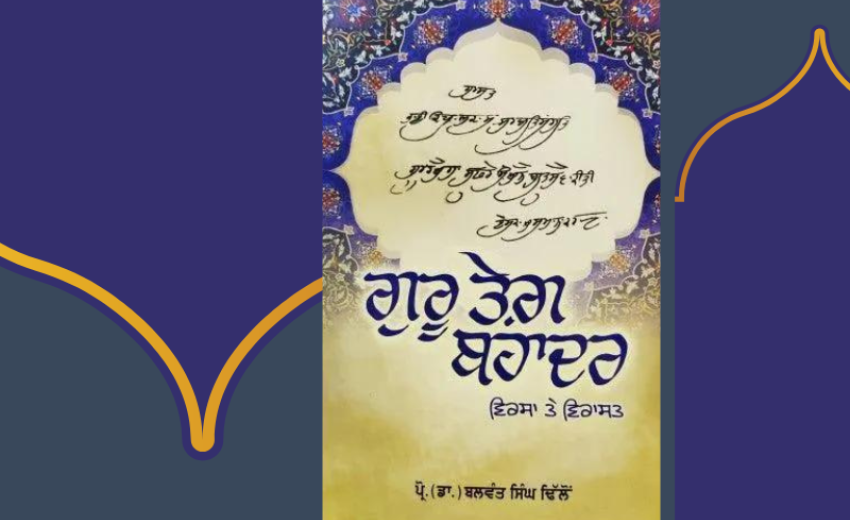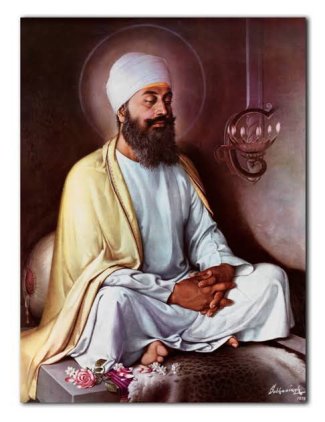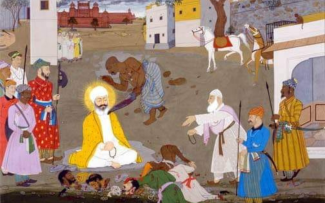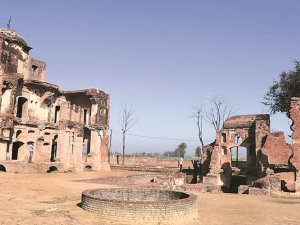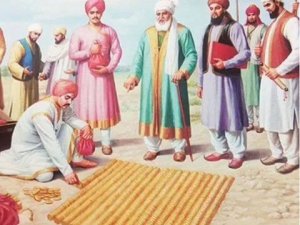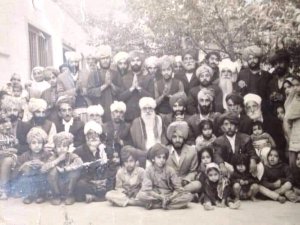Author: Prof. (Dr.) Balwant Singh Dhillon Publisher: Singh Brothers, Amritsar Price: Rs. 550 (Hardbound) Pages: 320
About the Author
Prof. (Dr.) Balwant Singh Dhillon is a renowned Sikh historian and researcher. He was formerly a Professor and Head at the Department of Guru Nanak Studies and formerly Director, of the Centre for Studies in Sri Guru Granth Sahib at Guru Nanak Dev University, Amritsar. During this period, he wrote two erudite books namely Early Sikh Scriptural Tradition: Myth & Reality and Interfaith Study of Guru Granth Sahib.
He retired from the University in 2010 and since then he has published several exceptionally well-researched books including Rajasthani Documents on Banda Singh Bahadur (2016), Banda Singh Bahadur Farsi Sarot (Punjabi, 2011), Sikh Itihas Di Farsi Itihaskari (Punjabi, 2022) and Guru Tegh Bahadur Virsa te Virasat (Punjabi, 2022).
The Book The book’s title, Guru Tegh Bahadur Virsa te Virasat could be translated in English as Guru Tegh Bahadur Heritage & Legacy. Every year some book on Guru Sahiban is written and published. Still, they lack in-depth research into early Punjabi manuscripts transcribed in the 18th century like the two Mahima Parkashs and three Gurbilas. The book has relied far less on mid to late-19th-century authors like Kavi Santokh Singh and Giani Gian Singh.
GURU TEGH BAHADUR VIRSA TE VIRASAT 115
CHAPTER REVIEW
As the book’s title refers to heritage and legacy, the book starts with Guru Nanak’s legacy and contribution. Unlike the Hindu Sadhus and Yogis who would renounce the world and lead a celibate life, Guru Nanak advocated against abandoning the worldly and family life. He encouraged doing Bhakti while leading a married life in society. Unlike other Hindu and Muslim Saints who kept quiet, Guru Nanak was vocal in his criticism of Babur, the founder of the Mughal dynasty in India for the cruelty and killings of innocent people. These were a few of the many spiritual legacies of the first Guru of the Sikhs, discussed in the book. Many verses of Guru Nanak from Guru Granth Sahib have been considered to illustrate the philosophy of Sikhi.
Chapter 2 gives a brief history of the next four Gurus namely Guru Angad, Guru Amardas, Guru Ramdas, and Guru Arjan. All major episodes or Sakhis like Humayun’s meeting with Guru Angad and Akbar’s arrival at Goindwal, the foundation of the new city Chak Ramdas which came to be known as Amritsar, the compilation of Guru Granth Sahib amongst others are mentioned using varied sources. Following the death of Akbar, Jahangir became the Mughal ruler and found support by aligning with the fanatical elements amongst the Muslim clergy. The martyrdom of Guru Arjan based on non-Sikh sources namely Jahangir’s autobiography, Father Jerome’s letter, Shiekh Sirhindi’s letter to Murtaza Khan, and Dabistan e Mahazib shows how the Mughal ruler and clergy were unhappy with growing popularity of Guru Arjan and Sikhi. The 18th century Sikh sources blame a revenue officer of Lahore, Chandu Lal/Shah for the martyrdom are grossly inadequate.
Chapter 3 is dedicated to the sixth Guru Hargobind. The martyrdom of Guru Arjanby Jahangir proved to be a turning point in Sikhi. The Sikhs were armed and trained to defend themselves under the Miri-Piri system. The circumstances leading to the imprisonment of Guru Hargobind at Gwalior Fort, the duration of confinement, and subsequent release are debated reviewing existing Sikh and Farsi sources. This is followed by the battles fought by the sixth Guru during the reign of Shah Jahan. The chapter clarifies the exaggerated friendship of Jahangir and Guru Hargobind. Guru Sahib established Kiratpur near Siwalik Hills as the new Sikhi center. Dhir Mal got an endowment from Shah Jahan in the form of a jagir which included the town of Kartarpur as his property. The Mughals recognised him as the Guru of the Sikhs.
Chapter 4 describes the contemporary situation of Mughal India at the time of Guru Tegh Bahadur assuming the responsibilities of Guruship. Aurangzeb imposed harsh conditions upon Hindus by stopping their puja in temples, reading sacred texts, and destroying their places of worship. After the death of Akbar, there was a change in the religious policy of the Mughals. Sikhi was seen as a hindrance to the spread of Islam. There were some ideological differences as well. Islam believes, their prophet was the last one and Sikhs call their Guru Sacche Padshah (the True King/Emperor). Many followers of Sakhi Sarwar also joined Sikhi. The chapter discusses and analyses how the taxation system on farmers led to agrarian crisis and revolt.
Chapter 5 deals with how the Sikh religion was organised during this period at Kiratpur. The challenges from Sodhis namely Minas, Dhirmalias, and Ram Rais were contained and neutralised. The Minas controlled Harmandar Sahib, and their leaders had written compositions in the pen name of Mahala 6, 7, and 8. Dhirmal claimed himself to be the Guru and so did the Ram Rai. Some of the Masands had aligned themselves with these sects and others had got arrogant. Eventually, Guru Gobind Singh had to disband the whole Masand regime.
Bhat compositions indicate the great spread of Sikhi during the Guruship of Guru Arjan. Dabistan e Mahazibstates that there is no city under Mughals where Sikhs cannot be found. Bhai Gurdas Vaaran tells us about the presence of Sikh sangat in Lucknow, Jaunpur, Patna, Rajmahal, and Dhaka. The resentment by Baba Siri Chand if any had subsided and in Udasis, Sikhi got preachers that travelled throughout India.
Chapter 6 narrates Aurangzeb’s views on Sikh Panth and his interactions with Sikh Gurus. History records that Guru Har Rai maintained a cavalry of 2200 soldiers. Dara Shikoh, the eldest son of Shah Jahan was of a Sufi temperament and became the governor of Lahore. It is generally believed that he would have met Guru Sahib during this period. He perhaps influenced his father and during the last few years, Shah Jahan became tolerant towards minorities. The chapter covers Ram Rai’s and Guru Harkrishan’s visit to Delhi at the behest of the Mughal ruler. Aurangzeb was keen to interfere in the Sikhi perhaps with the aim of controlling it.
Chapter 7 deals with the early life of Guru Tegh Bahadar till he became the ninth Sikh Guru. Contrary to the popular narrative, the author does not mention Guru Sahib meditating in a Bhora at Baba Bakala. The town is described as prosperous with many beautiful pools, wells, and baolis. Guru Sahib lived there with his wife and mother. He lived a strict and holy life, yet he was not a recluse and attended to family responsibilities. He made visits outside Bakala as well. The Hukamnamas have also been used to draw the account of Guru Sahib during this period.
Chapter 8 tries to put the travel of Guru Tegh Bahadar to Eastern India in chronological order using additional sources such as Malwa Desh Ratan Di Pothi, and hukamnamas amongst others.To understand the route to East India, the travelogues of contemporary visitors like Peter Mundy and Jean Baptiste Tavernier have been used. The first arrest of Guru Tegh Bahadar in 1665 has been discussed in detail using the Assamese source, Annals of Delhi Badshahat. This important event is missed in many Punjabi books on Guru Sahib.
Chapter 9 is about Guru Sahib’s travel from Patna to Dhaka & then to Assam. In this chapter, the author has introduced a new source. He has referred to Kolkata-based Sikh historian Jagmohan Singh Gill at least six times to chalk out the route and existence of Gurdwaras and Sikh colonies in Bihar, Bengal & Eastern India. The author has clarified using Assamese and Mughal sources that Guru Tegh Bahadar visited Assam with Raja Ram Singh of Amber at his request. Later Sikh sources erroneously gave multiple names of the Hindu Raja who went to Assam with Guru Sahib. Sadly, many Gurdwaras related to Guru Sahib in Bangladesh have been lost.
Chapter 10 is about Guru Sahib’s travel from Patna to Punjab. The author agrees with Dr Fauja Singh and here refers to the second arrest of Guru Sahib in 1670 by the Mughal authorities at Agra. Here Guru Sahib had a dialogue with Aurangzeb which seems correct as the Mughal ruler was not present in Delhi when Guru Sahib was martyred in 1675. The author speculates that Nawab Saif Khan may have intervened to secure the release of Guru Sahib.
Chapter 11 explores the bani, the compositions of Guru Tegh Bahadar which depicts the suffering of minorities under a cruel regime but gives them hope. The author also tries to estimate where Guru Sahib stayed the last 5 years of his life from 1670-75. Using Malwa Desh Ratan Di Sakhi Pothi, the author concludes that Guru Sahib was in Malwa during the Vaisakhi of 1674.
Chapter 12 deals with the critique of the historical sources on the martyrdom of Guru Tegh Bahadar including Farsi, English and Punjabi writings. Most non-Sikh historians have relied on Siyar-ul-Mutakhirin, written by Sayyid Ghulam Husain in 1782 which was commissioned by East India Company. Within a decade it was translated into English and the British proclaimed it as the most exhaustive and comprehensive account ever written on the history of India. Many non-Sikh historians right from JD Cunningham till today rely on it.
This account states that Guru Tegh Bahadar and Hafiz Adam, a disciple of Shaikh Ahmad Sirhindi (contemporary of Jahangir, in one of his letters he had expressed great delight at the execution of Kafir of Goindwal (Guru Arjan) had collected a large body of men. They moved about in the countryside and seized money and material by force. It was feared they might revolt against the government! Sayyid Ghulam Husains narrative on the Sikhs has been copied from a very biased account of Yahya Khan’sTazkirat-al-Muluk written in 1736-37. Hafiz Adam was banished by Shah Jahan in 1642, thirty-three years earlier. Hafiz went on a pilgrimage to Mecca and Medina where he died in 1643. Dr Fauja Singh in 1975 had quoted several works (with page numbers) to prove the discrepancy of the year by Ghulam Husain and the fallacy of his allegations. Ghulam Husain also copied other older Farsi accounts including Sujan Rai Bhandari. The author to his credit has critically examined Siyar-ul-Mutakhirin like never before.
Chapter 13 deals with the events leading to the martyrdom of Guru Tegh Bahadar. Traditional Sikh sources do not mention the arrest of Guru Sahib prior to 1675 and mix them up. The Sikh and Farsi sources are thoroughly probed and analyzed to paint a picture of those poignant days.
Chapter 14 is a discourse on the effects and consequences of the martyrdom of Guru Sahib.
The last chapter is on the multi-facade personality of Guru Tegh Bahadar. The author quotes hukamnamas where Guru Sahib tells the Sangat Guru Guru Japna and gives them confidence by writing Guru Rakha. In the compositions Guru Sahib introduces Insha poetry writing which is akin to the expression of one’s innermost feelings. The author notes the cursor writing of Guru Sahib which depict his artistic vision as well. Other aspects like righteousness, mercy, and justice have also been discussed.
CONCLUSION
The writers born and brought up in Punjab seem to treat the Sakhis related to Gurus as a matter of fact and do not try to find their original source or analyze them. This book has over 700 references and footnotes and many more in the body of the text. This will be a huge help for future students and scholars of Sikh history. In addition, the verses of Guru Granth Sahib have been used to describe to socio-economic-political environment of that time. This aspect has almost totally been ignored by many Sikhs and all non-Sikh historians perhaps due to lack of knowledge of Gurmukhi. The book also uses modern non-Punjabi scholarship on Mughal India to build the picture of how the socioeconomic, political, and religious environment of the country changed during the reigns of Akbar, Jahangir, Shah Jahan, and lastly Aurangzeb.
This is a remarkable book in Punjabi and perhaps the best on the subject and one could hope that it would be read and used by Sikh Parcharaks and Kathakars in addition to general readers.
This review was originally published by the author in Abstracts of Sikh Studies Journal.
